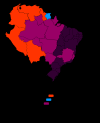Aniba canelilla (Kunth) Mez (Lauraceae): A Review of Ethnobotany, Phytochemical, Antioxidant, Anti-Inflammatory, Cardiovascular, and Neurological Properties
- PMID: 32528283
- PMCID: PMC7264103
- DOI: 10.3389/fphar.2020.00699
Aniba canelilla (Kunth) Mez (Lauraceae): A Review of Ethnobotany, Phytochemical, Antioxidant, Anti-Inflammatory, Cardiovascular, and Neurological Properties
Abstract
Aniba canelilla (Kunth) Mez, popularly known as "casca preciosa" (precious bark), falsa canela (cinnamon-scented) Casca-do-maranhão (bark of maranhão), and Folha-preciosa (precious leaf), is an aromatic species of the Lauraceae family, widely distributed in the Amazon region. In traditional medicine, it is indicated for the treatment of a great diversity of diseases, including digestive, respiratory, inflam]matory, painful, and central nervous system disorders, it is administered mainly in the form of tea or decoction orally. Its essential oil is referred to as a natural antioxidant for food preservation and disease control, showing great potential for use in the cosmetics, perfumery, and pharmaceutical products sector. The present review aimed to discuss critically and comprehensively the ethnobotanical characteristics, phytochemical constitution, and scientifically tested biological properties of A. canelilla, systematizing the knowledge about the species and proposing new perspectives for research and development. The chemical composition of A. canelilla includes 1-nitro-2-phenylethane, metyleugenol, eugenol, safrol, anabasin, anbin, tannin, α-pinene, b-pinene, b-felandren, b-caryophyllene, b-sesquifelandren, p-cymene, linalool, α-copaene, and spatulenol. Researches with ethanolic extracts, essential oils, and major constituents (1-nitro-2-phenylethane and metyleugenol) have revealed antioxidant, antinociceptive, anti-inflammatory, cardio-modulating, hypotensive (vasorelaxant), hypnotic, anxiolytic, anticholinesterase, and antibiotic properties (trypanomicidal, leishmanicidal, and antifungal). Some of these effects are potentially beneficial for aging-related diseases treatment, such as cardio and cerebrovascular, chronic inflammatory, neurological, and degenerative diseases. However, it is necessary to advance in the research of its clinical use and development of therapeutic products.
Keywords: 1-nitro-2-phenylethane; Aniba canelilla (Kunth) Mez; biological activities; folk medicine; methyleugenol; toxicity.
Copyright © 2020 Souza-Junior, Luz-Moraes, Pereira, Barros, Fernandes, Queiroz, Maia, Maia and Fontes-Junior.
Figures




References
-
- Almeida M. R., Martinez S. T., Pinto A. C. (2017). Chemistry of natural products: Plants that witness histories. Rev. Virtual Quimica. 9, 1117–1153. 10.21577/1984-6835.20170068 - DOI
-
- Araújo V. F., De Petry A. C., Echeverria R. M., Fernandes E. C., Pastore F. (2007). Plantas da Amazônia para Produção Cosmética: uma abordagem química - 60 espécies do extrativismo florestal não-madeireiro da Amazônia. Brasília, 244: Universidade de Brasilia.
-
- Barbosa T. D. M., Baitello J. B., Moraes P. L. R. (2012). A família Lauraceae Juss. no município de Santa Teresa, Espírito Santo. Bol. Mus. Biol. Mello Leitão 30, 5–178.
Publication types
LinkOut - more resources
Full Text Sources

